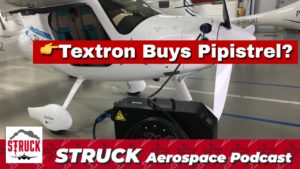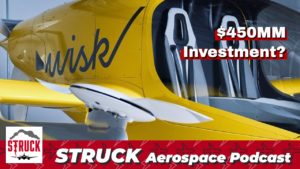In the episode we discuss Uber Elevate – where is it going, exactly? We talk about advances in propeller technology and ways wasps are impacting plane safety down in Australia, and what there is to be done about it.
Learn more about Weather Guard StrikeTape segmented lightning diverter strips. Follow the show on YouTube, Twitter, Linkedin and visit us on the web. Have a question we can answer on the show? Email us!
Podcast: Play in new window | Download
EP37 – Propeller Blade Advances, Uber Elevate & Animal Control at the Airport
All right. Welcome back to the podcast. On today today’s episode, we are going to cover a couple of really interesting animal related, uh, airport issues. Number one, a poor Brown bear got struck by a seven 37. Um, so we’ll talk about that wasps in Australia. Have been actually a wreaking havoc also on seven 30 sevens in their pitot tubes.
And we’ll also talk about a lightning strike, uh, that prompted a New Zealand air, um, aircraft to divert. So, you know, keeping up with some recent, uh, lightning strike news and our engineering segment, we’re going to chat about some interesting aerodynamics on, uh, on props and, uh, some aerodynamic stuff there.
We’re going to talk about a interesting new bell rotor, uh, tail rotor concept. And lastly, in our, uh, EVTOL segment. Uh, I know Allen has some pretty interesting thoughts on Uber elevate and just the scope and the, uh, the future of their business, because there’s a lot of stuff that seems very. Nebulous. And it’s starting to sound a little bit like maybe some, uh, as Scott Galloway, the business, um, professor would say yoga Babel.
So Allen let’s first talk about this, uh, bear strike. So that seems a really hard, how did the bear get on the runway, but also just really sad bears are super cool. Yeah, well, it’s up in Alaska and they had a Brown bear and a Cub crossing the runway as a seven 37 was landing. And there’s really not much to do about it.
And it, it acted like the pilot didn’t even see it obviously, or w. What had gone around and it’s an occasion, you see things about aircraft striking deer, right? So a deer is a slightly taller animal, tends to be, and aircraft hit those two is there’s a lot of, um, in today’s world, there’s a lot of periphery fences around airports because of nine 11.
So there’s not as much wildlife walking around on runways, but still wildlife gets in. And, and if the bears going from point a to point B and the run winds in the way, they’re going to walk across it. And then this particular case, it just hit the inlet on the engine. And Dan, they then have the inlet and obviously it tilled the bear, which is just a bad situation.
So I’m sure everybody just feels horrible about the whole thing that I’m sure it passengers saw it. It just doesn’t. This is nothing good about it, right? Yeah. Well, they said that Cub was on, on harmed. Yeah, not a poor guy, but poor gal mama bear. Yeah. I it’s terrible. I’ve seen cattle on runways, but it happened here locally.
One time there was a cow or cattle, cattle had gotten loose and, uh, th the local airport didn’t have a surrounding periphery fence at the time. So there’s cattle on the runway. Thank goodness and aircraft. Wasn’t trying to land because that would have been a real mess. But you just gotta be aware of that.
And runways are not like any different than a road and you see deer on the road and there’s drone runway. And then in Alaska, there’s bear on the runway and Canadian geese. Right. We all know about the airplane landed in the river, right? So aircraft around wildlife, a lot more than you think. I think if you actually go look at the number of interactions between aircraft running into some animal on the runway, it’s, it’s a lot, it’s a lot more than you think it would be.
So everybody’s got to keep their eyes open. I think Alaska is one of those places where you probably have to do it a lot more because it’s just a lot. More wilderness there then you’d say and Newark New Jersey. Yeah. Yeah. Well, and looking at this Alaska airliners, obviously the seven 37 is not that big of an aircraft, but only seems like so many parts are close enough.
Like I was looking like, what did, what hit this bear? Obviously you said it hit the, uh, you know, the lip of the engine, but you can only hit what the. The wheels and that that’s the only let me, it couldn’t possibly be tall enough to hit the nose. No, I hope not. Yeah. Maybe, maybe a moose, a moose. Good. Oh, I moved do a lot of damage, right.
That would, that would do a lot of damage. And I bet you, if you go back and look at flights into Alaska, somebody probably hit a moose. That was it. Just, just one of those things that you just can’t control, unless you really. Have a good perimeter security and an offense where they can’t hop over a crawl underneath.
And if they can, they’re going to be out there. It’s hard. Yeah. Well, so the, the next article I’d like to discuss is about Australian wasps. So these mud Dobber wasps have apparently been blocking a lot of Pitot tubes. And that seems much more difficult. Like for me, I’m kind of like, well, you know what, just make a better perimeter fence for all the money we spend on security.
That seems relatively controllable bears. Like bears are not small. Uh, but these wasps, and obviously I understand birds are just, you know, you can’t, you can’t control airspace from birds, but you know, these little wasps are plugging all these tubes. And why is that such a big problem? Well, the Pino tubes.
Tell you your airspeed and it’s always, uh, uh, problem, wherever those wasps or Hornets that like to make nests, especially the mud dobbers, because they make their nests out of mud. So they’re actually bringing in dirt with them to create, uh, a home. And, uh, if you’ve been around a wasp nest or a hornet’s nest, those little honeycombs slots that they like to live in.
So it, it gets really difficult if they see a nice little opening or a hole. Like if you have one on the edge of your roof, of your house, there’s always wassup in there like that. They’ll find those little cracks and crevices to go make a home in and pitot tubes are, can be the right size. To make a home inside of, and especially on like on a 737 there, the peanut probes aren’t really close to the ground.
So you can’t. Put your eyeballs on a look inside of them on a smaller, uh, like a Bonanza or a Cessna, one 82 or something of that sort of smaller aircraft, personal aircraft. You look inside those Pito tube to see if there’s critters crawling inside and you have them covered when you’re not flying the aircraft to keep the craters out.
But on a 737, it sits out overnight in Australia. You really can’t tell. And so you, you may have Hornets and wasps calling up inside there and trying to make a home and. If you don’t know what your airspeed is, that’s a big problem. Right? Okay. So aircraft, you really need to know what your speed is to fly the airplane properly.
And if it’s got some sort of blockage in it, you’re you got a world of hurt now. The article was really interesting because it was like a study done over a number of years about that, that, that impact. And was it like more than 50% of the cases were on 737s? Like they don’t like the Airbus, so they don’t like 56% of them were on the Boeing 737.
Yeah. That’s a crazy burn in the, a three 30 after that was about 20% of them. But yeah, it’s just gotta be the. Just the right diameter. Like you said, like, obviously they’re not going to nest in someone that’s huge when they’re, you know, the size of a finger. Right. So they just really liked the 737 tubes, but what’d you, what’d you figure that if you’re designing those Pitot tubes, that you would take that piece of information back and then do something that would prevent that because it’s a serious, it’s a serious thing.
Not knowing your speed’s a big deal or the whole. AOA, uh, issue with the seven 37 and M cast system, uh, right. Is this a central problem? Well, you got to insects causing sensor problems have to do with airspeed. Those are big problems. And you know, one of the things that has hurt, uh, aircraft over time is when they do put those red sleeves on.
Have you ever seen these things? They say remove before flight. It’s got a little tag hanging off it and they, they slide it over the Pitot probe we supposed to be before people forget to take those off. Uh, and have had accidents even though they’re red and they’re dangling out there and they’re noticeable.
Well, you’re not really going to notice a hornet’s nest up in a Pitot probe on a 737 until it’s too late. Right. Wow. Scary. Yeah. Just, just goes back to a, we talked about in multiple shows before, just that checklist, like you just got to go through all, like look inside every pitot tube. You can pull off the red and the red covers, like you said, just little things like that are easy to get missed if you just.
Don’t check off every item in your list. Oh yeah. And Australia is just a tough place. They already, right. Like spiders, the size of, you know, just like stalking you in the night. It’s terrifying all the creatures in Australia. Oh yeah. Don’t they have the highest number of poisonous creatures or at least creatures thinking that sounds right.
Yeah. Right. So just the, the, you gotta be hard. Freddy Krueger lives there too. And Jason, I think now a vacation. Yeah. Oh my gosh. Yeah. Well, right. Uh, this is one of those things about Australia. Like, man, there’s, they’re pretty tough down there. Right. And, uh, uh, but at the same token, I think we should be taking some of that data back, uh, especially if you’re designing a PIDO probes and making it a little more.
Insect resistant would be a good, good thing to go do. Yeah. So lightning strike, uh, prompted a New Zealand air, uh, ATR 72. So this is from simply simple flying.com and, uh, there’s a pretty like in-depth article, just talking about liking it. Knighting strikes in general, not just like quickly reporting this one incident, but, um, I mean a bunch of stuff out of, out of, uh, obviously that part of the world.
It is New Zealand heavy lightening area, or, I mean, what, what about this article sticks out to you? Yeah, I think Australia and New Zealand are prone to some decent number of lightning strikes and it’s probably just the way that they have where they’re flying to. Uh, they’re running across storms quite a bit, and they have a lot of lightning strikes there.
You read about. Strikes in New Zealand and Australia quite often in the press. I see him all the time where, you know, in the United States and in Europe are having roughly the same number of strikes or that you think that they would, but may the strikes are just more severe or they’re just more aware of them and, and a Southern hemisphere or something of the sort, because.
You see a lot of, uh, reported, reported lightning strikes on aircraft. And th th th the summary is pretty much the same for most of those reports, which is very good because the United States, I think reporting is garbage for the most part, if it’s just a general reporter, but in Australia and in New Zealand, they have a description of the aircraft are designed to take lightning strikes and lightning strikes occur Russ roughly once a year to most transport category aircraft.
And everybody is safe. There’s a fair day cage on the airplane. All that stuff is. True. So it’s a really good reporting that they have that we just don’t see the happy that his face. But I think it’s very, it’s, it’s fascinating to read an article that’s sort of general public general purpose article that’s has correct information at it.
So it’s nice to see it. And the are obviously. The airlines in New Zealand and Australia are very cognizant of, of inspection criteria and repairs that have to happen after having a lightning strike. So they seem to be doing all the right things, which is really, really good to see.
All right. So in our engineering segment today, first up on the docket is, uh, some interesting wind tunnel technology has been testing some new propellers. So. Um, Ellen, why don’t you start us off here. So what did you notice about this article from aerospace testing international.com? Well, you don’t think about testing propellers anymore.
That basically it says after world war two, there hasn’t been a lot of propeller technology and so to speak. Obviously they’re making them out of composite materials and they seem, they’ve get more aerodynamically shaped over time because we have the computational power to go do it, but to actually put some really.
A good amount of efforts at propellers shaped to reduce, uh, noise, right? Propeller noise is a big deal. Uh, and I thought, well, maybe the, the propeller industry’s going to get revitalized in some sense, all the EVTOLs are all propeller driven and there’s a lot of propellers on each one of those aircraft.
So maybe there is a new frontier and propellers, and it’s good to see at least that sort of fundamental research going back in. Because as you’ve seen Dan, a lot of the, the, the articles about is about noise. Yeah. It’s a big issue. Yeah, because these are getting closer and closer to cities and actually doing the air taxi.
Job. It’s got to be quieter. I mean, it has to think about how obnoxious it is to be anywhere near a helicopter. I mean, it’s, it’s just gotta be really quiet, right? Yeah. I think it was whisk. I was watching the video from whisk the other day where they’re comparing their aircraft to a helicopter and they had a helicopter, a certain distance away.
And how much, how much noise it was. And then there are craft. Comparable, obviously there’s a huge difference between the two. The helicopter is just playing on noisy. Uh, but the electric aircraft is, is a greatly reduced noise is because of the way that the propellers are set up and the electric motor.
But if they can actually lower that down even more, don’t you think there’s more applications in closer to the city like LA? I think Los Angeles is one of those places. They just don’t like helicopters in New York city. Doesn’t really care for them all that much either. But if they’re quiet, who cares?
Yeah, I should open up those markets in which they otherwise may not be able to get into. So, uh, at least, yeah. Do you remember reading the, the, uh, article from beta technologies on their aircraft, where they were making their own propellers? Right. That’s one of the things they did to save money early on.
I think they were making their own propellers and making a propeller is not a basic fundamental propeller is not necessarily rocket science. But making it quiet is it is a lot of science involved in it. And I kind of watched her, you know, at what point are they going to start? Everybody’s going to really start to switch over to these much quiet propellers, even in an electric aircraft is going to be driven to make it as quiet as possible.
And if the technology is there and we’re capable of making it, which we call the R. Then you almost wonder on the regulation side, you’re going to see the regulations, push them to be quiet, which are forced into this. Some of these new propeller designs could happen. And so, I mean, why do we need more actual wind tunnels and these anechoic chambers and stuff like that?
Why can’t we do it all? Um, you know, digitally now, are we still just not there yet? Uh, you can, you can. Uh, but there’s, it’s complicated anytime you it’s just like on, I went to and podcasts were uptime, the complexities of a propeller falling into the wake of the previous propeller. Causes difficult. And you got this, the propellors creates a hostile environment for flow.
So that can be really tricky. And the noise for the propellers can be tricky. It’s a little hard to predict, and that’s why they’re still in one tunnels doing some of those measurements because computationally, you’re really learning from the experimental data, empirical data, and then putting it into the computer to try to represent that because it’s just, it’s just so complicated, but I think.
With the, you see it on the wind turbine side. So on the wind term aside, you’re starting to see some more of that information come in and looking at the wakes on the previous blade and how it influences the blade behind it. Well, wind turbines, aren’t moving nearly as fast as propellors on an aircraft.
So the complexity just goes way, way, way up on an aircraft because of the speeds. So it’s just difficult. It’s really difficult as you can. Well, imagine. So bell is working on an electrically distributed anti torque tail rotor that they think can potentially, uh, re replace traditional ones. Um, Al looking at this technology is, does it seem feasible that they can actually do that?
Yeah, I think we’re close to doing that now that the bell design had four separate little fans. And with electric motors driving that. So they, you know, the efficiency is like, it’s not quite there. It seems like, but simplicity wise an electric motor as well. I mean, and maybe this is related to failure. If I had one big motor and that dies, then I don’t, I can’t keep my helicopter from spinning.
Right. It’s an anti-rotation device, anti torque device. So I have trouble. So breaking it into four, if one of them goes away, I’ve still have enough. To get home with, and maybe that’s the thought behind it. So there maybe there’s some systems safety aspects and which came up with that particular design, but it’s slick, right?
Because on a fun, a baseline helicopter design, do you have the main rotor? And then you have a drive shaft that goes to the back end, uh, to the tail rotor to drive the tail rotor should have got this big sort of transmission. System and these tubes drive shafts are in there to do all that. If you can take all that weight out and have an electric motor do the same thing, then you save a bunch of weight and complexity and get the same result.
Uh, so yeah, it makes a ton of sense to do. And years ago, I think it was Bella MacDonald, uh, had the hat instead of a tail rotor. They had, uh, basically the exhaust blowing out in a sort of a fan like feature or exhaust port sort of, that was the anti-rotation. Tail rotor replacement, which is pretty cool.
So it’s like a jet. Powered two rotors set up. And that was complicated because you’re using hot air and they had this rotating mechanism, which was complicated. Uh, so I haven’t really seen that. I remember that doing flight tests with that, but I haven’t really seen it in production anywhere. I haven’t seen that aircraft anywhere.
What this electric terror thing. That’s gotta be a slam dunk, right? Like, come on. It’s it’s it’s just making the life so much easier. Taking a bunch of weight, all the complexity out of the, out of the helicopter. Yeah. Why not? Right. And why not do it one? Why would it have taken this long, I guess is kind of how it feels to me as a, you know, not a rotocraft expert by any means, but like helicopters have been all around for a long time.
True. Like this doesn’t seem like a revolutionary idea. Like, why did it take so long, uh, on the motor? I think it’s related to the motor side. We’re seeing that with all of the electric you got to get to the point of having a very compact high energy density motor, because you want to add a bunch of dead weight.
Uh, motors are in terms of their, what they’re constructed of. They’re mostly copper, right? Copper is a heavy material, so they can be happy. So. You can’t get away from that so much. And you can just sort of make it denser and try to reduce other stuff. Uh, so motors over time have gotten definitely more compact.
There’s a lot more electronics to control them and to make them more. Uh, controllable speed-wise and for a lot of different things. So it’s sort part electronics, part motor design, and getting it where you can get a compact enough, you can shove in a tail rotor. I think that’s what it has been.
Conceptually, make an electric motor and putting propeller on it. Pretty straight forward things to do. Right. Uh, but I think it’s just a, this is probably mostly result as you can. Well, imagine of all the automotive, electric motors are going on that just that the technology has gotten better for that kind of thing.
And, uh, you know, the cost has come down, so it may make sense. Make it make it possible now. So, uh, in a lot of times the aircraft market leads the automotive market. And I think in this particular case, automotive market is leading the way.
All right. For our final segment today, we’re gonna talk about Uber elevate, uh, an Uber air. So they’ve released a, a 19 page PDF sort of outlining their plans for the future lists, a lot of authors and contributors. And, um, it’s interesting for sure. But Alan, this to you, uh, smells a little fishy. Is that how you would, uh, maybe characterize it?
Well in aircraft and aircraft, it’s sort of this, it’s the new frontier. You get a lot of that talk raw, raw, raw stuff. Yeah. We’re going to change what to change the world and everything’s. Yeah. Right. And, and aircraft still have that allure of being the coolest neatest thing. And it’s, it’s just like space X, right?
It’s the same sort of thing, but, you know, space X is actually doing it. And, uh, Uber elevate is in a different mode where they’re not really designing the aircraft. All they have, they’re sort of supporting the aircraft companies to develop different varieties of these things, trying to create a marketplace where these aircraft are developed.
And, but there’s not so much activity going on there as I thought there would be. And. Well, I want to read one of the paragraphs that in that presentation they put out to the day. Cause I think it was just fascinating because I couldn’t discern what they’re even talking about. It says Uber air is just one part of Uber’s vision for a holistically sustainable transportation future that serves cities around the world.
Our objective at Uber elevate is to build long-term engagements across the UAM. Ecosystem steered by shared values and organized around accountability and continuous communication to inform and support the creation of sustainable UAM networks. Working closely with communities and local governments is particularly important to ensuring that the benefits of UAM has to offer are fully and equitably achieved.
I don’t know what that means. I have no idea what that means. And I’m a person that’s had been in aerospace a long time, and I’ve seen a lot of things coming in and out of aerospace and a lot of sort of shaky things come in and out. And that makes no sense to me. What are they even talking about? They talking about having airports.
Is that what we’re talking about? Are we talking about equity? Yeah. Achieved? What, how about this? If you want to make an aircraft as a, as a taxi in your taxi, how about building an air taxi? Let’s do that first. So let’s get the aircraft built first, before we start changing the world, because the problem has been for the last 40 years was we hadn’t been able to build the aircraft.
To change the world seven 37 dash eight. It’s not changing the world. It isn’t right. The Airbus three 83 80 didn’t change the world didn’t wear away. We had that, that world changing aircraft. In the last 50, maybe 50 plus years, we just have it, especially on the smallest, small end, the Cessna, the Cessna aircraft that, you know, the, the single engine piston airplane that’s been around since the 1950s, it hasn’t really changed all that much.
So the Bonanza is in the fifties or late forties, early fifties. So those are crafters 50, 60, 70 years old. We really haven’t changed anything at that time. A fundamental level. The, you know, the, the latest, I would say the latest in achievement has been like the Cirrus Sr 20 Sr 22, and some of the diamond aircraft and ended up on that forefront just because they’re composite, not metallic airplanes, but what are we doing?
As an industry, if, if we’re not focused on building that aircraft, because none of this happens without having an aircraft that’s even viable and a company that can make them and make some money off of them, that none of this will happen. All, all the advanced I can fly from Los Angeles to San Francisco or whatever they want to do will never happen without not having an aircraft.
They can actually accomplish it. So. And doesn’t am I missing something here? Dan, is there, is there more to this that that should be connecting again? It seems like a lot of glossy photos and fancy pictures of important people, but that doesn’t build an airplane. Yeah. It’s a very buzzwordy PDF. Like there’s, there’s one page that says using data analysis to target and inform initial community outreach.
And they’re basically talking about how the, you know, they’re making sophisticated modeling tools that can help us identify and evaluate. Different configurations. And then they’re trying to predict demand and humans, aren’t that good at predicting demand. And I don’t know how you predict demand for air taxis.
So like you get the first one, like we can’t even predict how many people are going to take the coronavirus vaccine. We have like, no idea, no idea. I mean, and then to say, like, how fast are we going to adopt these, these brand new. I just seems like there’s just a lot of pie in the sky stuff here where, like you said, they’re kind of putting the cart before the horse where we don’t know if you, we just genuinely don’t know if there really is a market for this air taxi stuff.
We just don’t know. Does it still have that Tesla feel to it? But Tesla was a totally different thing. And that since that tussle was going to build the car, regardless, whether they could make it as a company or not was a result of building the car. That’s the first step where there’s an eco infrastructure for electric vehicles.
Well, the costs have come along with the car, but the car is the thing. That’s, that’s the starting point. If the car is no good, the rest of it doesn’t does not matter. Right. And I, I think that’s probably the point where missing there’s you got to get to the car. Now, the thing about watching that EBTL.
Industry develop is there’s going to be winners and losers here. And I was doing a little more research. I’m keeping tabs of how the companies are doing, and then you see the engineers kind of float around and watch who’s going where. There, there, there there’s one part of this I think is gonna be very hard to beat in terms of the company.
And I think, uh, the, the heavy side by kitty Hawk slash whisk, uh, has this feature. And so does Joby, which is, uh, th they basically tilt the, the motor. Up for vertical flight and then they mechanically bring it back down for four flight. That feature by itself. It’s going to set those companies apart because it’s the most efficient, probably the most efficient to design.
They can never have. You want to get to four or flight as fast as you can. And aircraft that have propellors that are just stationary. Like they’re just for vertical lift and you shut them off for four flight is dead weight. It’s either got to help lift the aircraft or we don’t need it. Uh, but. I think those two companies really have an advantage.
Now the heavy side, that’s a worst possible Naval aircraft. I understand where it comes from. I get all that, but you never name an aircraft heavy side. Yeah. It’s like, yeah, you don’t call your girlfriend fat. You know, you just don’t do any of that stuff. Yeah, that’s right. It’s going to be light and nimble.
That’s what the whole aircraft industry about. But I will say this, you know, th the Uber elevate. Conception is I think, and then the argument is an air taxi. That’s all great because here’s the thing about that smaller aircraft market that is just so frustrating. And I listen to a lot of different aircraft podcasts and the ones that are sort of pilots specific.
It’s a lot of our, the aircraft podcast talks about, uh, Crashes a small aircraft. So they’re just reliving the crash, relive in the crash, reliving the crash and it just over and over, if you listen to it enough, it’s just like, listen to an obituary. It’s all that it is. And at some level, and I understand why they do, because they’re trying to make everyone else aware, like, don’t do this, right?
But at some point we have to have technology that gets us out of the don’t do this where the pilot can’t do that. The pilot can’t fly into the side of a mountain. The pilot can’t fall asleep because it doesn’t matter. Cause the aircraft will take over and get you where you want to go. I think from an industry standpoint, we need to stop having the crashes, which are mostly pilot related, vast majority of pallet related, not mechanical issues.
So is there a place where the veto market to make aircraft safer? No doubt so much safer. It’s going to be so much safer to fly one of those. Then it will be to fly assessment one 82, just because of the technology is better. And the safety features are better, but as Uber elevate kind of do it probably maybe, or someone like Joby gonna do it.
Yeah. I think they got a pretty good pathway to success. Well, it also just seems. From my point of view, that the first thing would be like, let’s build a plane that has a legit commercial market. Like we talked about in our wind turbine podcast, you know, carting people from, you know, the port over to an offshore site to an oil rig.
Like, why don’t you just like sell a thousand, you know, aircraft to do that job and do it really well for a bunch of years. Right? And then say, Hey, this works, we’ve proven this out. We figured out a lot of bugs. It was sort of like our beta testing. And now. Maybe we should build some airports in a city and like, this can actually work.
We figured out a lot of these bugs rather than like, let’s try to start by saving the world. And, uh, that seems the wrong way to go. Crazy history has proven that. Right. And eclipse eclipse aviation popped up again because, um, Years ago, back in the two thousands, they were going to build, I don’t know, 3000 aircraft.
And I think they ended up building like 150, 200 and had gone bankrupt. And that company went through a bankruptcy again a week or so ago. Uh, but we’ve been down this pathway before they’re going to have this world changing aircraft and they couldn’t make the aircraft. So it all depends. No one remembers it.
I mean, you ask people today what it was eclipse aviation. They don’t have any idea what you’re even talking about. That wasn’t that long ago. Right. And you’d hate for some of these other aircraft companies kind of get in that mode of, Hey, we’re going to change all the world. No, no, you will. You, you have a great product.
We’ll do that, but let’s get the product figured out first and get it flying and then, and then get to change it. We’re rolling. Right? One step at a time, one step at a time. All right. Well, that’ll do it for today’s episode of struck. If you’re new to the show. Thank you so much for listening. And please leave a review and subscribe on iTunes, Spotify, or wherever you listen to podcasts.
Check out the weather guard, lightening tech YouTube channel for video episodes, full interviews and short clips from the show. And follow us on LinkedIn, Twitter, Instagram, and Facebook. Our handle is @WGlightning tune in next Tuesday for another great episode on aviation, aerospace engineering and lightning protection. Strike tape, weather guard, lightning techs, proprietary lightning protection for radomes provides unmatched durability for years to come. If you need help with your radon lightning protection, reach out to us at weatherguardaero.com.












